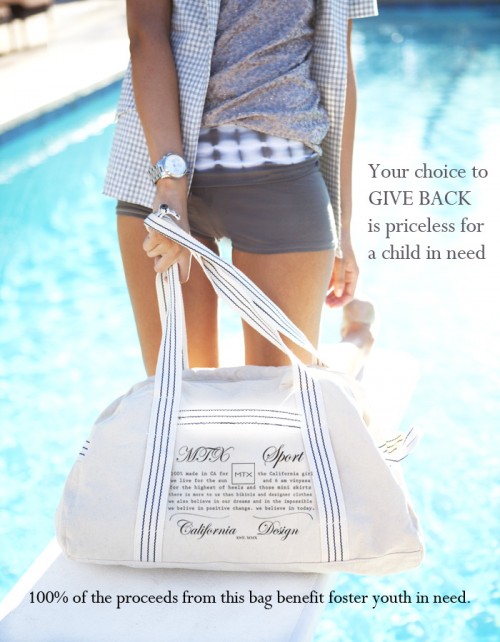 Morris Terry is a sustainable lifestyle brand based in Sacramento, CA. Launched by local designers Marisa Minasian and Terry Buccat, Morris Terry is a self proclaimed advocate of both healthy personal living and healthy community. Through their charity line, not only can you purchase one of the most unique, beautiful gym bags we’ve ever seen – 100% of your purchase goes back to HELPS, a local foster agency in Sacramento California, to fund extracurricular activities for children who would otherwise be unable to participate due to financial circumstances.
Morris Terry is a sustainable lifestyle brand based in Sacramento, CA. Launched by local designers Marisa Minasian and Terry Buccat, Morris Terry is a self proclaimed advocate of both healthy personal living and healthy community. Through their charity line, not only can you purchase one of the most unique, beautiful gym bags we’ve ever seen – 100% of your purchase goes back to HELPS, a local foster agency in Sacramento California, to fund extracurricular activities for children who would otherwise be unable to participate due to financial circumstances.
This week, we asked Terry, a few questions about how sustainable design, causes and why foster care is so close to this fantastic company’s heart.
FGS: Why did you choose to work with sustainable materials?
Terry: Morris Terry is a sustainable lifestyle brand and to us, sustainable living embodies caring not only for ourselves, but to also provide back to our community. Over the years I had done a lot of work with underprivileged populations- I’ve worked in low-income clinics that provided free health care to the homeless, tutored San Quentin inmates, and was an educational mentor to homeless youth that lived in transitional housing with their families. Although I was doing what I could to give back, I always felt like I could be doing more.
FGS: How and why does your work combine fashion with a cause?
Terry: When [Marisa and I] together to talk about starting a fashion business, we were inspired by the possibility of using our business as a tool to promote social change, especially in serving as advocates for foster youth. Each season we design an item in which proceeds from sales are donated to support foster youth.
FGS: What is your current cause?
Terry: This Spring, our charity item is the
MTX Gym Bag. Proceeds from sales are going towards providing the opportunity for foster youth to participate in the arts, theater programs and various extracurricular activities. In particular, the proceeds are being donated to HELPS Foster Agency that serves our CA community.
FGS: Why Foster Care?
Terry: When my mother and father decided to become foster parents 7 years ago, and opened their home up to foster youth, I was exposed to a whole new world of children who needed a lot of support from the community. These youth needed foster parents to support basic needs of food and shelter, educational tutors to help them stay on track in school, therapists of all sorts to deal with emotional trauma, and volunteers to hopefully take them out and do normal kid things. It took a village to help a single foster youth live as normal as a life as possible. As I was experiencing all of this with my family, I realized that I wanted to be able to give foster youth more than just a normal life.
My business partner Marisa (aka “Morris”) was adopted from Korea when she was 3 months old. Her mother worked as a social worker for 18 years and placed numerous foster youth into loving homes. Learning about the foster system was something she just heard about her whole life. Marisa is also a very creative being- she has the most unique, artistic way of looking at the world. I think this creative view just comes to her naturally, but also, her mom and dad recognized this early on and cultivated it. Marisa grew up expressing herself through art her whole life. Marisa’s parents knew how important extracurricular activities and the arts were for a child’s development, which unfortunately, is not the case for every family, especially foster families. There currently is no budget set aside for extracurricular activities for foster youth.
 Morris Terry is a sustainable lifestyle brand based in Sacramento, CA. Launched by local designers Marisa Minasian and Terry Buccat, Morris Terry is a self proclaimed advocate of both healthy personal living and healthy community. Through their charity line, not only can you purchase one of the most unique, beautiful gym bags we’ve ever seen – 100% of your purchase goes back to HELPS, a local foster agency in Sacramento California, to fund extracurricular activities for children who would otherwise be unable to participate due to financial circumstances.
Morris Terry is a sustainable lifestyle brand based in Sacramento, CA. Launched by local designers Marisa Minasian and Terry Buccat, Morris Terry is a self proclaimed advocate of both healthy personal living and healthy community. Through their charity line, not only can you purchase one of the most unique, beautiful gym bags we’ve ever seen – 100% of your purchase goes back to HELPS, a local foster agency in Sacramento California, to fund extracurricular activities for children who would otherwise be unable to participate due to financial circumstances.
